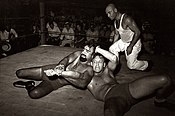
Back فيس (مصارعة) Arabic Babyface (wrestling) Danish Face Spanish Face (catch) French Pegulat baik ID Face (wrestling) Italian ベビーフェイス (プロレス) Japanese 선역 (프로레슬링) Korean Face (professioneel worstelen) Dutch Face (luta profissional) Portuguese
This article needs additional citations for verification. (December 2009) |

| Part of a series on |
| Professional wrestling |
|---|
 |
In professional wrestling, a face (babyface) is a heroic, "good guy", "good-doer", or "fan favorite" wrestler, booked (scripted) by the promotion with the aim of being cheered by fans.[1] They are portrayed as heroes relative to the heel wrestlers, who are analogous to villains.[2] Traditionally, face characters wrestle within the rules and avoid cheating while behaving positively towards the referee and the audience. Such characters are also referred to as blue-eyes in British wrestling and técnicos in lucha libre. Not everything a face wrestler does must be heroic: faces need only to be clapped or cheered by the audience to be effective characters. When the magazine Pro Wrestling Illustrated went into circulation in the late 1970s, the magazine referred to face wrestlers as "fan favorites" or "scientific wrestlers", while heels were referred to as simply "rulebreakers".
The vast majority of wrestling storylines involve pitting faces against heels,[3] although more elaborate set-ups (such as two faces being manipulated by a nefarious outside party into fighting, or simply having a clean sportsmanly contest)[4] often happen as well. In the world of lucha libre wrestling, most técnicos are generally known for using moves requiring technical skill, particularly aerial maneuvers and wearing outfits using bright colors with positive associations (such as solid white). This is contrasted with most villainous rudos who are generally known for being brawlers, using physical moves that emphasize brute strength or size while often having outfits akin to demons or other nasty characters.
- ^ "Torch Glossary of Insider Terms". PWTorch.com. 2000. Archived from the original on June 6, 2011. Retrieved July 10, 2007.
- ^ Foley, Mick. Have A Nice Day: A Tale of Blood and Sweatsocks (p.2)
- ^ Sharon, Mazer (1998). Professional Wrestling: Sport and Spectacle. Univ. Press of Mississippi. ISBN 9781604736557.
- ^ Whatever Happened to Gorgeous George by Joe Jares, Tempo Books, 1974, p. 85, description of clean match in early 1970s Texas between Dory Dixon and José Lothario